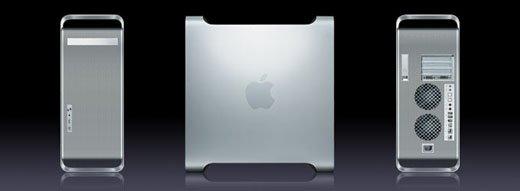No more mysteries: Apple's G5 versus x86, Mac OS X versus Linux
by Johan De Gelas on June 3, 2005 7:48 AM EST- Posted in
- Mac
Introduction
It is a professional 64 bit Dream machine with supersonic speed! It is beautiful. It is about the ultimate user friendliness. It is about a lifestyle. It is a class apart. You guessed it - I am parroting Apple’s marketing.For some reason, the performance of Apple’s gorgeous machines has been wrapped in a shroud of mystery. Yes, you could find a benchmark here and there, with one benchmark showing that the PowerMac is just a mediocre PC while another shows it off as a supercomputer, the unchallenged king of the personal computer world.

If you like a less performance-obsessed article about Apple, OS X and the G5, you should definitely give Anand’s articles in the Mac section on AnandTech a read...
In this article, you will find a pedal to the metal comparison of the latest Xeon DP 3.6 GHz (Irwindale), Opteron 250, Dual G5 2.5 GHz and Dual G5 2.7 GHz.
Scope and focus
Apple’s PowerMac is an alternative to the x86 PC, but we didn’t bother testing it as a gaming machine. Firstly, you have to pay a big premium to get a fast video card – as a standard, you get the ATI Radeon 9650 - even on the high-end PowerMacs. Secondly, there are fewer games available on this platform than on the x86 PC. Thirdly, hardcore gamers are not the ones buying Apples, but rather, creative professionals.So, we focus on workstation and server applications, especially the open source ones ( MySQL, Apache) as Apple is touting heavily on how important their move to an “open source foundation” is.
The 64 bit Apple Machines were running OS X Server 10.3 (Panther) and OS X Server 10.4.1 (Tiger), while our x86 machines were also running a 64 bit server version of a popular Open Source Operating Unix system: SUSE Linux SLES 9 (kernel 2.6.5). We also included an older Xeon 3.06 GHz ( Galatin, 1 MB L3) running SUSE SLES 8 (kernel 2.4.19) just for reference purposes. Some of the workstation tests were done on Windows XP SP2.










116 Comments
View All Comments
tfranzese - Friday, June 3, 2005 - link
Kind of snappy there Johan.I do prefer numbers coming from one source myself.
JohanAnandtech - Friday, June 3, 2005 - link
Rubikcube: Speculative? Firstly, Both a webserver and a database server show terrible performance. Secondly, LMbench shows there is definitely a problem with creating threads. So everything point into our "speculative" conclusion.Thirdly, as mentioned in an earlier post:
http://www-106.ibm.com/developerworks/linux/librar...
is another indication that there is nothing speculative about our conclusion.
rubikcube - Friday, June 3, 2005 - link
#21 I disagree. Most of the end of the article on the threading problems was speculative. We can't say that's the cause without actual testing.Jalf - Friday, June 3, 2005 - link
To those wanting a Linux on G5 test, keep in mind the entire purpose of this article. It was to test the performance of a Mac computer running a Mac OS, compared to a Intel/AMD PC.So while installing Linux on the G5 would give us a better idea of how the CPU itself performs, it would also leave out the huge effect the OS also has (You wouldn't have seen the huge performance problems with threading, for example.)
Jalf - Friday, June 3, 2005 - link
#11: Not true, if you browse AMD's documentation for a bit, they do say that their TDP *is* the absolute max power.Intel uses the "maximum power achievable under most circumstances"-method though.
rubikcube - Friday, June 3, 2005 - link
I agree that linux should have been used for a more normalized comparison. I also think that you should have tried running your mysql tests from darwin on x86. You might have been able to find the cause of the performance anomalies.Sabresiberian - Friday, June 3, 2005 - link
I find it hilarious that someone calling him- or herself 'porkster' is complaining about someone else's language :)Apple's computers have made their fame on their user-friendliness, so I think it is very appropriate to compare these computers with OSX on the Apples, as that's where the user-friendliness resides and both OSes are in the same family. It would have been fun to compare using the 64 bit Win XP Pro - I bet we would all get a good laugh out of that. Microsoft is determined, I think, to make a Linux man out of me yet :)
kresek - Friday, June 3, 2005 - link
waiting for AnandTech's YDL results, have a look at this:http://www-106.ibm.com/developerworks/library/l-yd...
SMOG - Friday, June 3, 2005 - link
#13 Thresher: "When it comes down to it, performance is important, but not the only reason people buy what they buy. I would say more often than not, the decision is made with only a modicum of logic."Your right, and those people didn't read this article, at best they read the first page then skipped to the last to see if he bashed Apple or not. This article was for those who want to know just what the power of the PowerPC actually is. This is a technical artical, not a buyers guide. This is science.
Good Job.
CU - Friday, June 3, 2005 - link
You mentioned most people don't use the Intel compiler, but it would have been nice to see it and also the windows compiler and the ibm compiler.